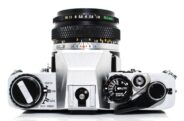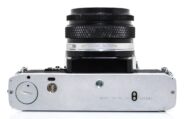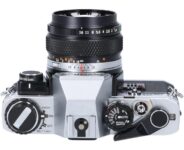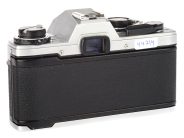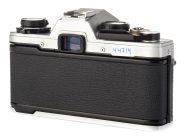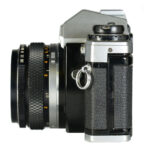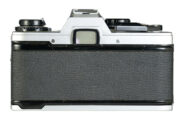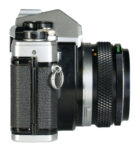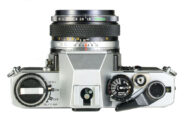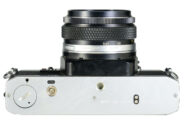Olympus OM10
35mm MF film SLR camera
Specification
| Production details: | |
| Announced: | 1979 |
| System: | ● Olympus OM (1972) |
| Format: | |
| Maximum format: | 35mm full frame |
| Film type: | 135 cartridge-loaded film |
| Mount and Flange focal distance: | Olympus OM [46mm] |
| Shutter: | |
| Type: | Focal-plane |
| Model: | Electronically controlled |
| Speeds: | 2 - 1/1000 |
| Exposure: | |
| Exposure metering: | Through-the-lens (TTL), open-aperture |
| Exposure modes: | Aperture-priority Auto |
| Physical characteristics: | |
| Weight: | 430g |
| Dimensions: | 135x84x50mm |
Manufacturer description #1
Join the electronic camera age. Forget the fiddling and worrying that rob photography of so much pleasure - and far too many fine pictures. But don't forget the performance and versatility every professional rightly insists on. That's the invitation of the fantastic OLYMPUS OM-10. A 35SLR camera that's extraordinarily light and compact. But utilizes electronic circuitry so sophisticated and reliable, exposure errors and photographer slip-ups are next to impossible. A camera with superb system versatility to bring any subject, anywhere, into your range - in the acclaimed OLYMPUS OM tradition.
The OLYMPUS OM-10. A masterpiece of failsafe electronic functionality.
Nothing is quite so frustrating as capturing a unique photographic opportunity - only to find you forgot a setting, and ruined the picture. Everyone forgets sometimes, but the unparalleled array of electronic monitor and control devices built into the OM-10 guarantees it won't cause you any lost opportunities.
Extra Powerful Twin Electrondc Brains
To handle its various automatic functions, the OM-10 utilizes two newly developed, high input impedance, high speed bipolar MSI Central Processing Units as twin electronic brains, which control shutler speeds and viewfinder display independently. Highly efficient and reliable new circuitry eliminates the need for the exposure control condenser of conventional auto SLRs. A unique feature of the input mechanism is ultra fast response utilizing the TTL Direct Light Measuring method.
TTL Direct Light Measuring
Created and perfected by OLYMPUS, pioneered in the sensational OM-2, TTL Direct Light Measuring is the only auto exposure system that works on real time.
In the viewfinder of a single lens reflex camera (SLR), you see an image captured by the lens, then reflected up by the mirror and through the pentaprism. When you press the shutler butlon, the mirror swings up to allow this image to reach the film. In normal SLRs, the light measuring cells are located in the viewfinder section, so when the mirror swings up, they are cut off from the image and can no longer read the light value. To control the exposure, they have to read the light before you take the picture, and store the information in a memory device. If the light changes suddenly, they get the exposure wrong.
In the OM-10 the light cell, an ultra-sensitive SBC, is located in the front of the camera pointing backwards. It starts working AFTER the mirror is raised, and directly reads the light that hits the film plane, DURING the exposure. This SBC is monitored by the electronic brain, which flicks the shutler closed at the exact instant enough light has been allowed through. Naturally TTL Direct Light Measuring needs no memory device, making it not only more accurate, but simpler and more reliable too. It's a system that just can't go wrong.
Random Pattern Shutter
A computer-generated random digital patlern on the shutler curtain enables the SBC light cell to obtain a perfectly balanced exposure reading.
Light and Sound - Unique Twin Indicator System
The OM-10 is the first camera in the world to feature a foolproof audio-visual indicator system. A Piezoelectric Ceramic Vibrator (PCV) combines with a super bright GaAlAs LED to indicate battery check and self-timer operation, emitting continuous or intermittent electronic tone and warning light. This provides an unmistakable dual function check in light or dark conditions.
Automatic Flash Setting
The OM-10's electronic brain automatically sets the correct shutter speed of 1/60 sec. when the special T20 electronic flash unit is fitted to the camera hot shoe and switched on.
Multi-Function Viewfinder Display
The viewfinder of the OM-10 is designed to be as simple as possible in order to avoid distracting the photographer. But it also conveys a wealth of useful information. A series of LEDs along the left hand margin provides an instant shutter speed indication (from 1/1,000 sec. to 1 sec.). Another LED above this display indicates over-exposures. Above the shutter speed indication is one more LED, which lights up to show when the T20 electronic flash is fully charged. A unique feature is the correct flash exposure check function. After the flash has been correctly exposed, the LED blinks repeatedly to confirm the picture will turn out as expected.
Special, Energy-Saving Preview Switch
The viewfinder LED display is activated in three different ways: by turning the Selector Dial to ON, by lightly pressing the shutter release button prior to taking the picture, or by lightly touching the special switch projecting alongside the release button. The display switches off automatically 90 seconds later in order to conserve the batteries.
Mode-Override Safety Device
Even if you forget to switch the Selector Dial to ON, a special safety device will assure proper automatic exposure of your pictures.
Automatic Shutter Lock
If the batteries are exhausted, an electromagnetic safety device automatically locks the shutter. It re-opens when new batteries are inserted.
Manufacturer description #2
The Olympus OM-10 is a single lens reflex camera of the finest quality in which the automation of photographic functions has been made possible by employing the most advanced electronics. To its acceptability of Olympus interchangeable lenses, a special film winder, a flash, and a host of other accessories are added to make it a complete system of photography. With the OM-10 you can gradually widen your enjoyment of the photographic art.
***
CAMERA TYPE: 35mm single lens reflex camera with electronic control automatic exposure and focal plane shutter.
IMAGE FORMAT: 24 x 36mm.
LENS MOUNT: Olympus OM Mount, bayonet type.
SHUTTER: Electronically controlled focal plane shutter.
FLASH SYNCHRONIZATION: X contact. Direct contact only.
AUTOMATIC EXPOSURE CONTROL: Aperture-priority electronically controlled shutter. TTL direct light measuring system. Light measuring range: EV-0.5 to 18 from 2 sec. to 1/1000 sec. at normal temperatures and humidity with ASA 100 and F1.2 standard lens. Exposure compensation: ±2EV. Automatic flash exposure: Normal auto flash (at 2 aperture settings F4 and F8 with ASA 100 film) is automatically set to X synch. (1/ 60 sec.) in conjunction with the electronic flash T20.
MANUAL EXPOSURE CONTROL: The optional Manual Adapter attached to the OM-10 permits a full range of 11 manual shutter speeds. (1 to 1/1,000 sec.). By setting the mode selector lever to the manual mode, the shutter speed can be set to 1/60 sec.
FILM SPEED RANGE: ASA 25 to 1600.
BATTERY CHECKER: Battery voltage can be checked by both LED and PCV. Mirror lock to limit drainage.
POWER SOURCE: Two 1.5V alkaline-manganese batteries LR44 (A76), or two 1.5V silver oxide batteries SR44 (Eveready EPX-76 or equivalents).
VIEWFINDER: Pentaprism type.
FOCUSING SCREEN: Microprism/sprit image-matte type.
FINDER VIEW-FIELD: 93% of actual picture field.
VIEWFINDER MAGNIFICATION: 0.92X with the 50mm lens at infinity.
VIEWFINDER INFORMATION: 12-step shutter speed scale and flash charge indicated by LEDs.
MIRROR: Oversize, quick return mirror.
FILM ADVANCE: Lever type with 130° angle, It can be wound with one long or several short strokes. 30° pre-advance angle. Power winding is possible with the Olympus OM System Winder 2.
SELF-TIMER: Electronic self-timer with about 12 second delay.
ACCESSORY SHOE: Built-in type, with direct contact.

